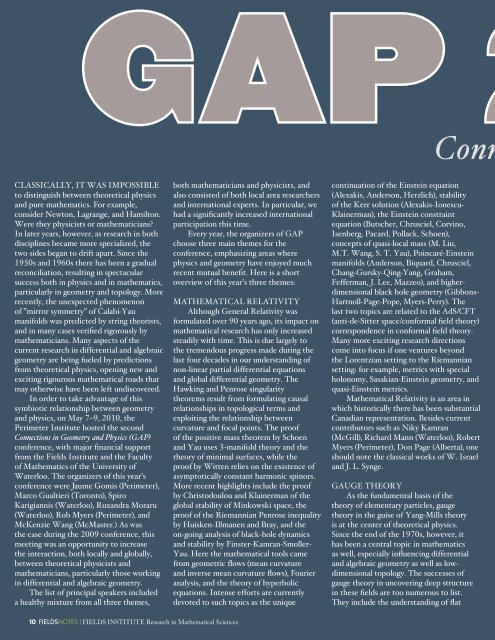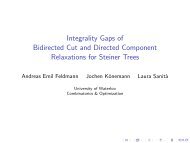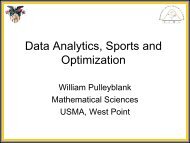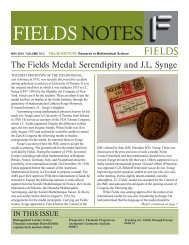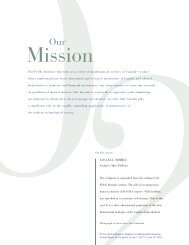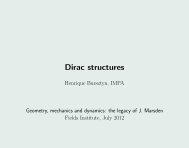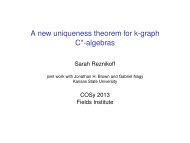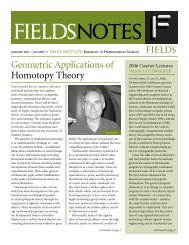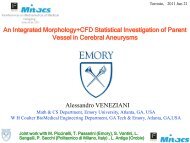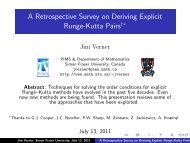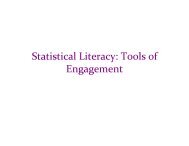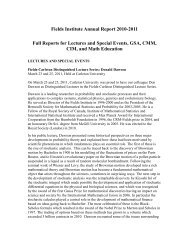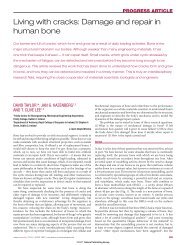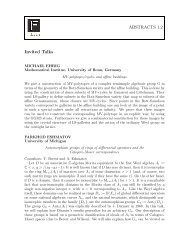SCIENTIFIC ACTIVITIES - Fields Institute - University of Toronto
SCIENTIFIC ACTIVITIES - Fields Institute - University of Toronto
SCIENTIFIC ACTIVITIES - Fields Institute - University of Toronto
Create successful ePaper yourself
Turn your PDF publications into a flip-book with our unique Google optimized e-Paper software.
GAP 2<br />
Conn<br />
CLASSICALLY, IT WAS IMPOSSIBLE<br />
to distinguish between theoretical physics<br />
and pure mathematics. For example,<br />
consider Newton, Lagrange, and Hamilton.<br />
Were they physicists or mathematicians?<br />
In later years, however, as research in both<br />
disciplines became more specialized, the<br />
two sides began to drift apart. Since the<br />
1950s and 1960s there has been a gradual<br />
reconciliation, resulting in spectacular<br />
success both in physics and in mathematics,<br />
particularly in geometry and topology. More<br />
recently, the unexpected phenomenon<br />
<strong>of</strong> “mirror symmetry” <strong>of</strong> Calabi-Yau<br />
manifolds was predicted by string theorists,<br />
and in many cases verified rigorously by<br />
mathematicians. Many aspects <strong>of</strong> the<br />
current research in differential and algebraic<br />
geometry are being fueled by predictions<br />
from theoretical physics, opening new and<br />
exciting rigourous mathematical roads that<br />
may otherwise have been left undiscovered.<br />
In order to take advantage <strong>of</strong> this<br />
symbiotic relationship between geometry<br />
and physics, on May 7–9, 2010, the<br />
Perimeter <strong>Institute</strong> hosted the second<br />
Connections in Geometry and Physics (GAP)<br />
conference, with major financial support<br />
from the <strong>Fields</strong> <strong>Institute</strong> and the Faculty<br />
<strong>of</strong> Mathematics <strong>of</strong> the <strong>University</strong> <strong>of</strong><br />
Waterloo. The organizers <strong>of</strong> this year’s<br />
conference were Jaume Gomis (Perimeter),<br />
Marco Gualtieri (<strong>Toronto</strong>), Spiro<br />
Karigiannis (Waterloo), Ruxandra Moraru<br />
(Waterloo), Rob Myers (Perimeter), and<br />
McKenzie Wang (McMaster.) As was<br />
the case during the 2009 conference, this<br />
meeting was an opportunity to increase<br />
the interaction, both locally and globally,<br />
between theoretical physicists and<br />
mathematicians, particularly those working<br />
in differential and algebraic geometry.<br />
The list <strong>of</strong> principal speakers included<br />
a healthy mixture from all three themes,<br />
10 FIELDSNOTES | FIELDS INSTITUTE Research in Mathematical Sciences<br />
both mathematicians and physicists, and<br />
also consisted <strong>of</strong> both local area researchers<br />
and international experts. In particular, we<br />
had a significantly increased international<br />
participation this time.<br />
Every year, the organizers <strong>of</strong> GAP<br />
choose three main themes for the<br />
conference, emphasizing areas where<br />
physics and geometry have enjoyed much<br />
recent mutual benefit. Here is a short<br />
overview <strong>of</strong> this year’s three themes:<br />
MATHEMATICAL RELATIVITY<br />
Although General Relativity was<br />
formulated over 90 years ago, its impact on<br />
mathematical research has only increased<br />
steadily with time. This is due largely to<br />
the tremendous progress made during the<br />
last four decades in our understanding <strong>of</strong><br />
non-linear partial differential equations<br />
and global differential geometry. The<br />
Hawking and Penrose singularity<br />
theorems result from formulating causal<br />
relationships in topological terms and<br />
exploiting the relationship between<br />
curvature and focal points. The pro<strong>of</strong><br />
<strong>of</strong> the positive mass theorem by Schoen<br />
and Yau uses 3-manifold theory and the<br />
theory <strong>of</strong> minimal surfaces, while the<br />
pro<strong>of</strong> by Witten relies on the existence <strong>of</strong><br />
asymptotically constant harmonic spinors.<br />
More recent highlights include the pro<strong>of</strong><br />
by Christodoulou and Klainerman <strong>of</strong> the<br />
global stability <strong>of</strong> Minkowski space, the<br />
pro<strong>of</strong> <strong>of</strong> the Riemannian Penrose inequality<br />
by Huisken-Illmanen and Bray, and the<br />
on-going analysis <strong>of</strong> black-hole dynamics<br />
and stability by Finster-Kamran-Smoller-<br />
Yau. Here the mathematical tools came<br />
from geometric flows (mean curvature<br />
and inverse mean curvature flows), Fourier<br />
analysis, and the theory <strong>of</strong> hyperbolic<br />
equations. Intense efforts are currently<br />
devoted to such topics as the unique<br />
continuation <strong>of</strong> the Einstein equation<br />
(Alexakis, Anderson, Herzlich), stability<br />
<strong>of</strong> the Kerr solution (Alexakis-Ionescu-<br />
Klainerman), the Einstein constraint<br />
equation (Butscher, Chrusciel, Corvino,<br />
Isenberg, Pacard, Pollack, Schoen),<br />
concepts <strong>of</strong> quasi-local mass (M. Liu,<br />
M.T. Wang, S. T. Yau), Poincaré-Einstein<br />
manifolds (Anderson, Biquard, Chrusciel,<br />
Chang-Gursky-Qing-Yang, Graham,<br />
Fefferman, J. Lee, Mazzeo), and higherdimensional<br />
black hole geometry (Gibbons-<br />
Hartnoll-Page-Pope, Myers-Perry). The<br />
last two topics are related to the AdS/CFT<br />
(anti-de-Sitter space/conformal field theory)<br />
correspondence in conformal field theory.<br />
Many more exciting research directions<br />
come into focus if one ventures beyond<br />
the Lorentzian setting to the Riemannian<br />
setting: for example, metrics with special<br />
holonomy, Sasakian-Einstein geometry, and<br />
quasi-Einstein metrics.<br />
Mathematical Relativity is an area in<br />
which historically there has been substantial<br />
Canadian representation. Besides current<br />
contributors such as Niky Kamran<br />
(McGill), Richard Mann (Waterloo), Robert<br />
Myers (Perimeter), Don Page (Alberta), one<br />
should note the classical works <strong>of</strong> W. Israel<br />
and J. L. Synge.<br />
GAUGE THEORY<br />
As the fundamental basis <strong>of</strong> the<br />
theory <strong>of</strong> elementary particles, gauge<br />
theory in the guise <strong>of</strong> Yang-Mills theory<br />
is at the center <strong>of</strong> theoretical physics.<br />
Since the end <strong>of</strong> the 1970s, however, it<br />
has been a central topic in mathematics<br />
as well, especially influencing differential<br />
and algebraic geometry as well as lowdimensional<br />
topology. The successes <strong>of</strong><br />
gauge theory in uncovering deep structure<br />
in these fields are too numerous to list.<br />
They include the understanding <strong>of</strong> flat


